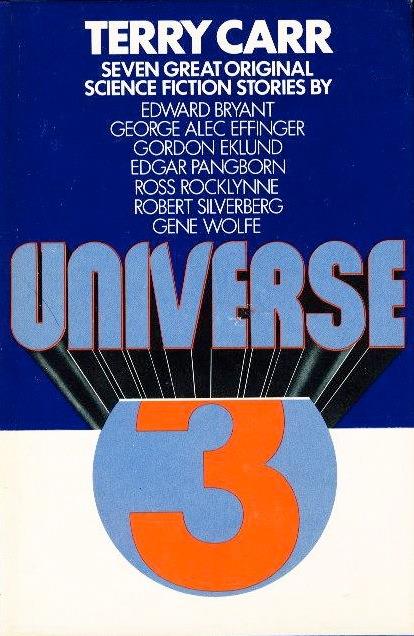Many Mansions
- by Robert Silverberg
- Novelette
- Science Fiction
- Adults
- Definite Time Travel
- English
- “Many Mansions” by Robert Silverberg, in Universe 3, edited by Terry Carr (Random House, October 1973).
With eleven years of marriage behind them, Ted and Alice’s fantasies frequently start with a time machine and end with killing one or another of their spouse’s ancestors before they can procreate. So naturally, they each end up at Temponautics, Ltd. Oh, and Ted’s grandpa has some racy fantasies of his own.
In Silverberg’s Something Wild Is Loose (Vol. 3 of his collected stories), he posits that this story is “probably the most complex short story of temporal confusion” since Heinlein’s “By His Bootstraps” (1941) or “—All You Zombues—” (1959), but I would respectfully disagree. In particular, I would describe Heinlein’s two stories as the most complex short stories of temporal consistency in that there is but a single, static timeline and (in hindsight) every scene locks neatly into place within this one timeline. By contrast, Silverberg story involves multiple time travel choices by the characters in what I would call parallel universes. The confusion, such as it is, stems more from what appears to be alternate scenes in disconnected universes rather than temporal confusion per se.
In Silverberg’s Something Wild Is Loose (Vol. 3 of his collected stories), he posits that this story is “probably the most complex short story of temporal confusion” since Heinlein’s “By His Bootstraps” (1941) or “—All You Zombues—” (1959), but I would respectfully disagree. In particular, I would describe Heinlein’s two stories as the most complex short stories of temporal consistency in that there is but a single, static timeline and (in hindsight) every scene locks neatly into place within this one timeline. By contrast, Silverberg story involves multiple time travel choices by the characters in what I would call parallel universes. The confusion, such as it is, stems more from what appears to be alternate scenes in disconnected universes rather than temporal confusion per se.
—Michael Main
On the fourth page Alice finds a clause warning the prospective renter that the company cannot be held liable for any consequences of actions by the renter which wantonly or wilfully interfere with the already determined course of history. She translates that for herself: If you kill your husband’s grandfather, don’t blame us if you get in trouble.

Tags
(11)
- Time Periods
- Age of Reptiles (252 Ma to 66 Ma: Mesozoic/Triassic/Jurassic/Cretaceous): the Pleistocene
- Circa AD 1940 to 1949: Most of the travel is to 1947.
- Circa AD 2000 to 2099: starting time
- Time Travel Methods
- Time Booths, Wardrobes, et al.: [. . .] an upright coffin-size box of dark grey metal, festooned with dials and levers.
- Themes
- Exiled or Intentionally Stranded in Time: Ted’s minor fantasy about stranding Alice
- Grandfather Paradox: one minor fantasy of Ted’s
- Messing with Someone’s Ancestors: multiple times
- Time Cops: two of Alice’s trips, possibly fantasizing
- Time Travel Agencies, Safaris, and Tourists: Temponautics, Ltd.
- Fictional Tags
- Groupings
Variants
(1)
- “Many Mansions” by Robert Silverberg, in Universe 3, edited by Terry Carr (Random House, October 1973).
Translations
(5)
- French.
“Des mondes en cascades” [Cascading worlds] by Robert Silverberg, in Après nous le délire, edited by Jacques Chambon (Casterman, January 1977). - French.
“Des mondes en cascades” [Cascading worlds] by Robert Silverberg, in Le livre d'or de la Science-Fiction: Robert Silverberg (Presses Pocket, March 1979). - French.
“Des mondes à profusion” [Worlds of profusion] by Robert Silverberg, in Les jeux du capricorne (Flammarion, September 2002).. . . . . . . . . . . . . . . . . . . . . . . . . . . . . . . translated by unknown persons - German.
“Mordgelüste” [Thirst for murder] by Robert Silverberg, in Jetzt Plus Minus (Goldmann, June 1977). - German.
“Viele Häuser” [Many houses] by Robert Silverberg, in Zielzeit, edited by Karl Michael Armer and Wolfgang Jeschke (Heyne, March 1985).
Indexer Notes
(1)
- First Release—Silverberg states in Something Wild Is Loose that Terry Carr published this story “in his third of his Universe anthologies, and it has been reprinted several times since.” We assume that the appearance in Carr’s 1973 original anthology series appeared before Silverberg’s 1973 collection, Unfamiliar Territory.
